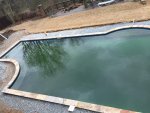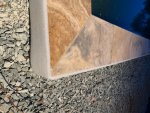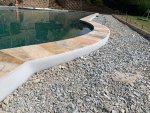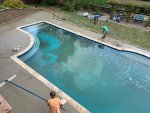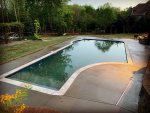How Thick Should my Poly Void be behind the coping
- Thread starter wxman18
- Start date
You are using an out of date browser. It may not display this or other websites correctly.
You should upgrade or use an alternative browser.
You should upgrade or use an alternative browser.
18,
All the pools I have seen, including mine, have a 3/4" gap between the coping and the deck.. Filled with Poly void and some type of caulk on top of that..
Let's see if we can get some of our other members to chime in...
Thanks for posting,
Jim R.
All the pools I have seen, including mine, have a 3/4" gap between the coping and the deck.. Filled with Poly void and some type of caulk on top of that..
Let's see if we can get some of our other members to chime in...
Thanks for posting,
Jim R.
- Jul 21, 2013
- 52,229
- Pool Size
- 35000
- Surface
- Plaster
- Chlorine
- Salt Water Generator
- SWG Type
- Pentair Intellichlor IC-60
I am not sure what Poly Void is. If you are talking about a pool expansion joint it is typically 5/8” to 1” that is then filled with foam backer and caulk.
Thanks. I did find this other product that is similar. The top peels back after you pour and you can then fill it with pool caulking. DECK-O-FOAM - Expansion Joint Filler - W. R. Meadows
Not to hi-jack your thread, but do some PB's make the gap smaller and not use anything? Is there a benefit to this besides dirt/junk getting in this crack? Is it strictly aesthetics?
The Deck-O-Seal website and how-to videos look legit and great Jim!
The Deck-O-Seal website and how-to videos look legit and great Jim!
- Jul 21, 2013
- 52,229
- Pool Size
- 35000
- Surface
- Plaster
- Chlorine
- Salt Water Generator
- SWG Type
- Pentair Intellichlor IC-60
Not to hi-jack your thread, but do some PB's make the gap smaller and not use anything? Is there a benefit to this besides dirt/junk getting in this crack? Is it strictly aesthetics?
The pool with it’s coping on top needs to move independant of the deck. If the deck is hard against the coping something is going to crack. The expansion joint needs to be filled with flexible foam and caulk.
Expansion Joint Caulking Around Inground Swimming Pools
The pool with it’s coping on top needs to move independant of the deck. If the deck is hard against the coping something is going to crack. The expansion joint needs to be filled with flexible foam and caulk.
Expansion Joint Caulking Around Inground Swimming Pools
Ok great response. Want to make sure PB is planning on doing this important step.
I saw on a previous thread that a 1/4" joint will work and the reason some are 3/4" has to do with the fact many forms that are used to pour the concrete are 3/4" thick. I would prefer to use 1/4" because it will look better and require less caulking. I'm probably going with the deck o seal.
Last edited:
I saw on a previous thread that a 1/4" joint will work and the reason some are 3/4" has to do with the fact many forms that are used to pore the concrete are 3/4" thick. I would prefer to use 1/4" because it will look better and require less caulking. I'm probably going with the deck o seal.
Keep us updated on process and post before and after pictures if you can!
Good luck WX.
- Jul 21, 2013
- 52,229
- Pool Size
- 35000
- Surface
- Plaster
- Chlorine
- Salt Water Generator
- SWG Type
- Pentair Intellichlor IC-60
I saw on a previous thread that a 1/4" joint will work and the reason some are 3/4" has to do with the fact many forms that are used to pour the concrete are 3/4" thick. I would prefer to use 1/4" because it will look better and require less caulking. I'm probably going with the deck o seal.
Problems Due to Concrete Decks
The most important bit of information to remember is the expected expansion in concrete caused by temperature change. Between the heat of summer (pool deck surface at 130º to 140º) and the dead of winter (pool deck surface at 30º to 40º) we can expect at least a 100º temperature change. The critical number to remember is that a 100 foot wide section of concrete will expand approximately 3/4 of an inch with a 100º temperature change. The expansion in lesser widths of concrete can be easily determined by proportioning the 3/4“ per 100 feet. The force of expanding concrete is very high and can easily shear off the coping or bond beam without properly installed isolation joints.
A 1/4” expansion joint may protect you if you have less then a 30’ run of concrete deck. I would rather have a wider margin and make it at least 5/8”. The risk of failure is too high to cut it close.
Please pardon my ignorance, I’m not trying to hijack the thread. I’m new to this and don’t want to mess up my build. I’m doing an owner build and would like to know, if I have to put the expansion joint or foam on my pool deck and coping even if it’s travertine coping and decking ? Thanks in advance
- Jul 21, 2013
- 52,229
- Pool Size
- 35000
- Surface
- Plaster
- Chlorine
- Salt Water Generator
- SWG Type
- Pentair Intellichlor IC-60
Please pardon my ignorance, I’m not trying to hijack the thread. I’m new to this and don’t want to mess up my build. I’m doing an owner build and would like to know, if I have to put the expansion joint or foam on my pool deck and coping even if it’s travertine coping and decking ? Thanks in advance
You need to understand that the pool is a separate structure from the deck. They need to be able to move independently. They will have different thermal expansion through heat and cold cycles and ground can shift over time.
If you tie then together through the coping and deck touching you will eventually get cracks. The cracks could show in the deck or they could be in the pool.
UPDATE I went with 1/2" Poli Void. The top of the foam peals back after you pour the concrete and you then fill that void with caulking. I used spray adhesive on the back of the coping and the edge of the foam to get it to stay in place.
Attachments
shannnon
0
UPDATE I went with 1/2" Poli Void. The top of the foam peals back after you pour the concrete and you then fill that void with caulking. I used spray adhesive on the back of the coping and the edge of the foam to get it to stay in place.
This looks amazing. We are owner builder also and are ready to pour concrete decking next to our flagstone coping. I am just now learning about expansion joints. Where do you get this material? Did you install it yourself or did you have a concrete sub do it?
Thread Status
Hello , This thread has been inactive for over 60 days. New postings here are unlikely to be seen or responded to by other members. For better visibility, consider Starting A New Thread.
Similar threads
- Replies
- 6
- Views
- 203
- Replies
- 2
- Views
- 342
- Replies
- 45
- Views
- 1K
- Replies
- 25
- Views
- 1K
- Replies
- 16
- Views
- 254


